Evelo Galaxy SL E-Bike Review, 2024
This accessible, retro e-bike offers high-end features at an economical price point.
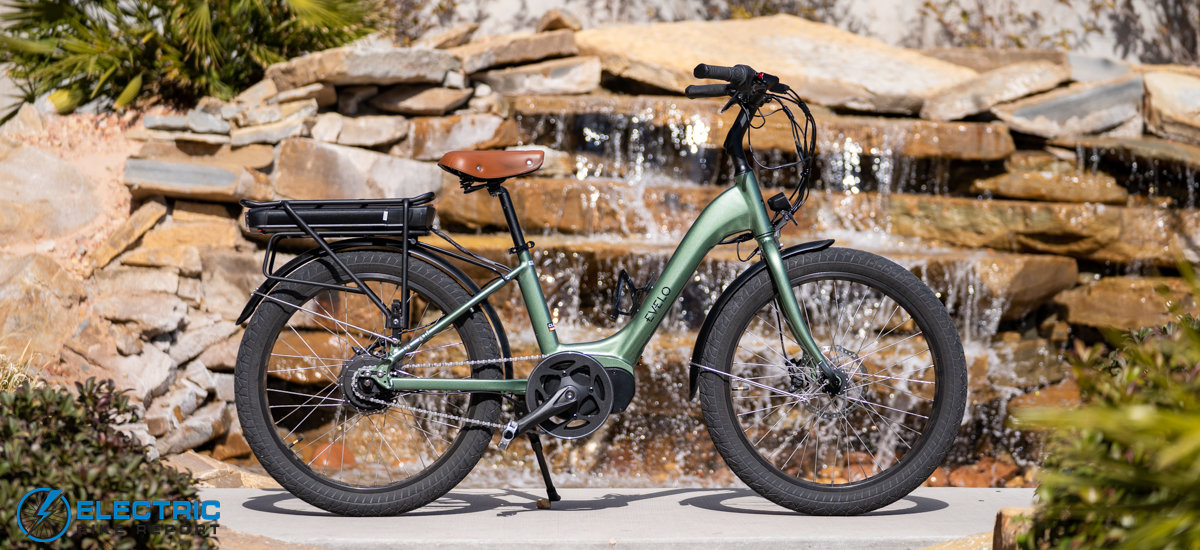
The Galaxy SL has been designed with casual and senior riders in mind, by creating a small, lightweight e-bike with a step-thru frame for easy mounting. The SL aims to offer a traditional riding experience with its 500W mid-drive motor, while incorporating an advanced, gearless continuously variable transmission (CVT) for greater flexibility than a standard geared drive. The SL comes standard with a full complement of quality components, and its pedal assist system (PAS) is well-tuned for offering consistent increases in power.
Read on for our thorough review of the Evelo Galaxy SL! We cover its specs and performance in detail so you know what to expect from this nostalgically-styled e-bike.
Note: if your interested in the Evelo Galaxy SL, see how it stacks up against the more affordable cruiser like the Velotric Discover 2, or the Specialized Turbo Como.
 Pros
Pros- The Galaxy SL features a traditional-bicycle-like riding experience with its surprisingly zippy 500W mid-drive motor.
- Accessibility is front and center with the Galaxy SL’s step-thru frame design and low 16.5” standover height.
- Much lighter than your average cruiser, weighing in at just 53.6 lbs with its battery included, the lightweight Galaxy SL is easily transported by most standard bike racks.
- As the more economical model in the Galaxy line, the SL maintains a high level of quality with reliable, name-brand components.
- Evelo’s four-year, 20,000 mile warranty is a stamp of quality on their entire line of e-bikes.
- Across the board, the pedal assist system (PAS) of the Galaxy SL provides controlled increases of power from levels 1 through 5.
- Evelo’s Galaxy line proudly displays classic styling that may be a trip down memory lane for some riders. It’s just a sleek-looking ride.
 Cons
Cons- The Galaxy’s small, lightweight frame can accommodate average height, heavier riders, but riders taller than 5’10” may need to browse other Evelo options.
- While saddle comfort tends to be a personal preference, our testers unanimously agreed that the SL’s saddle was decidedly on the firm side. Fortunately, Evelo offers alternative saddle and suspension seatpost options as separate accessories, but they are additional purchases.
- Battery : Lithium Ion 36V, 13Ah w/ Advanced Battery Management Software
- Display: Evelo C800 IPS Multi-Color 3.7” Display
- Motor: Dapu 500W Continuous, 740W Peak, 95Nm Torque. Patented Brushless Design, Torque and Speed Sensor Control
- Headlight: Fully Integrated Spanninga Kendo Front
- Taillights: Fully Integrated Lineo Rear
- Pedal Assist: 5 levels of Pedal Assistance
- Range: Up to 50 miles on Pedal-Assist
- Throttle: Handlebar Mounted Throttle
- Claimed weight: 46.8 lbs (without battery) / 53.6 lbs (with battery)
- Maximum rider weight: 350 lbs.
- Maximum load on rear rack: 55 lbs.
- Brakes: Zoom Hydraulic Disc Brakes w/ 180 mm Front, 160 mm Rear
- Fenders: Composite All Weather Front and Rear Fenders
- Fork: EVELO Rigid 4130 Chromoly Fork
- Frame: Hydroformed Aluminum 6061T6
- Drivetrain: KMC Chain Drive w/ Enviolo® Continuously Variable Transmission
- Grips: Ergonomic Rubber
- Saddle: Selle Royal Comfort Springer Saddle
- Handlebar: Cruiser-style w/ EVELO Stargazer 110 mm Stem
- Kickstand: Yes
- Pedals: Wellgo LU-C33
- Tires: CST Cyclops 24” x 2.4”
Evelo Galaxy SL Review: E- Bike Overview
The main differences between the Galaxy SL and its higher-priced sibling are in their battery and drivetrain. The SL features a 36V, 13Ah battery and a chain-driven, gearless CVT with a manual twist shifter, while the Lux comes equipped with a 48V, 11.6 Ah battery and belt-driven CVT with automatic shifting. The Galaxy SL makes some compromises in the technology department to reduce costs, but it is in no way an inferior product. Tried and tested traditional chain drives still exist for a reason, and the SL’s CVT remains an uncommon addition in the world of e-bikes that offers much more flexibility than a traditional geared cassette.
As the more economical Galaxy model, the SL is not nearly as high-tech, but it still offers a full lineup of quality, name-brand components. From its surprisingly powerful Dapu 500W, 95Nm brushless mid-drive motor to its Enviolo twist shifter and CVT, the Galaxy SL is outfitted with reliable parts, each with tested history. Evelo clearly stands behind their products. Like other Evelo e-bikes we’ve reviewed, the brand offers an extraordinary 4-year, 20,000 mile (yes, you read that correctly) warranty on each of their e-bikes, in case of any unexpected hiccups in manufacturing or performance.
The Galaxy SL doesn’t only stand out due to its nostalgic form and high-grade parts; Evelo has put a heavy emphasis on accessibility with this design. The SL is seriously lightweight for an e-bike; it’s not uncommon to see them in the range of 70-80 lbs. With the SL weighing just 53.6 lbs, it is much easier to lift, and also much easier to transport as it fits within the weight capacity of most bike racks. Both Galaxy bikes also feature a step-thru design with a low standover height of just 16.5” for ease of mounting.
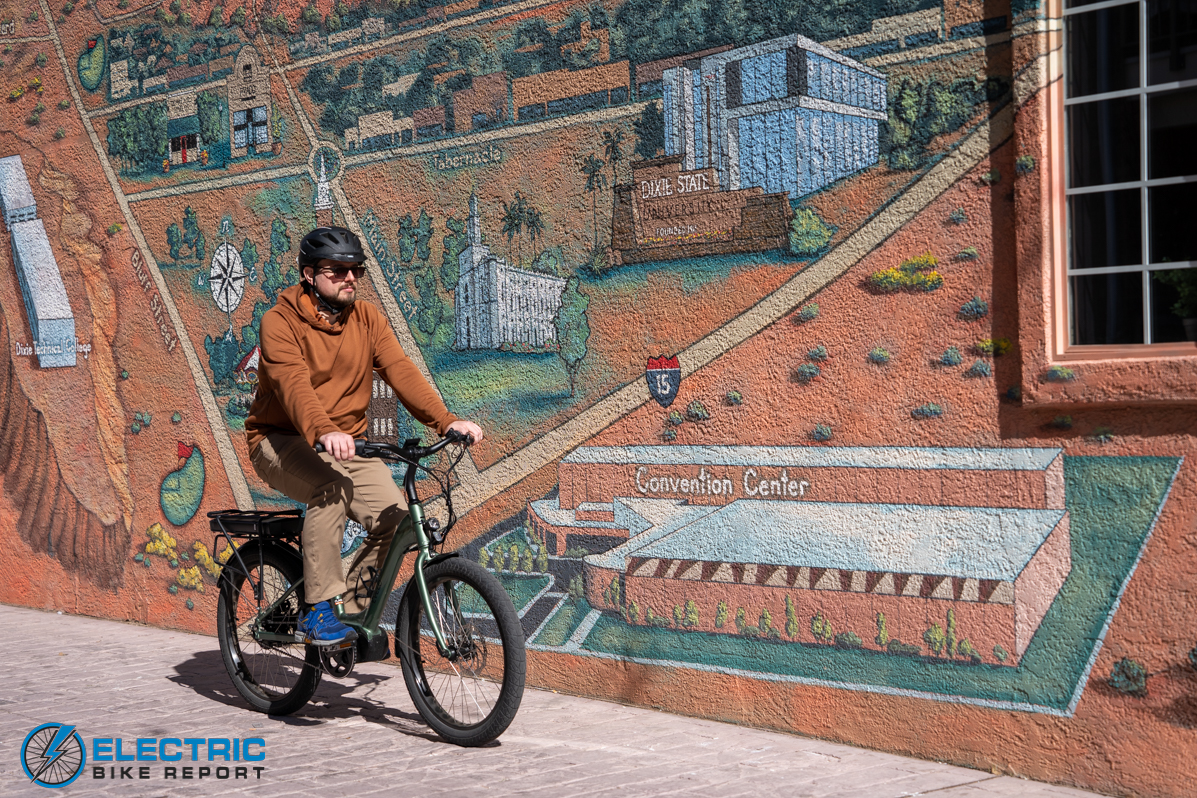
The Galaxy SL is suitable for casual rides around the neighborhood, but also just as capable for use as a daily commuter.
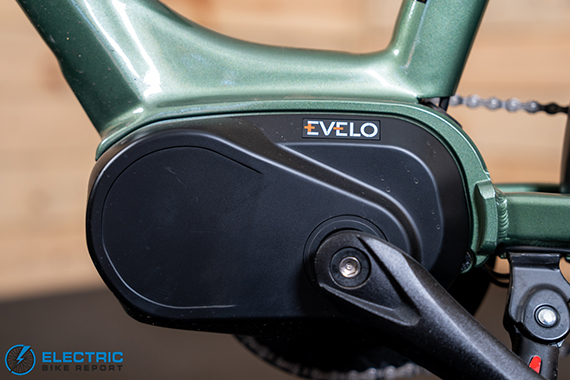
A 500W mid-drive motor allows the Galaxy SL to feel more like a non-electric bike.
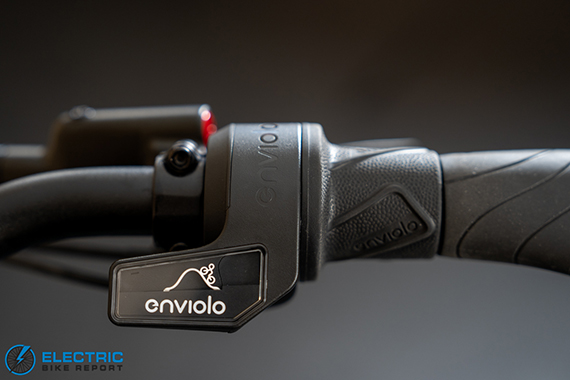
The twist shifter on the right handlebar adjusts the bike’s gearless Enviolo CVT.
Part of the tradeoff in having such a lightweight frame, however, is in size; both Galaxy models have relatively small frames. While they can handle riders up to 350 lbs, they are more limited in the area of rider height. The Galaxies are designed for a range of average heights between 4’10” and 5’10”, so taller riders looking for a similar design may need to consider the Evelo Compass or Omega as alternatives.
Curious about how the Galaxy SL performed in our series of tests? Keep going for more information!
Evelo Galaxy SL Review: Circuit Speed Test
To get an idea of the Evelo Galaxy SL’s motor performance and the differences between its PAS levels, I took the e-bike through our circuit test (explained in detail in the graphic above). This allowed me to get to know the SL in stages, and adjust to some of the qualities that separate it from many other e-bikes.
I have to admit that when I first saw the Galaxy SL, speed was definitely not the first thing that came to mind. I was pleasantly surprised to find that the bike’s 500W, 95Nm motor could feel pretty zippy at times, though the fact that it is a mid-drive motor ensured that the SL never felt like it was getting away from me.
The Galaxy SL’s pedal assist system is tuned in a way that we at Electric Bike Report really like to see; each level provides a controlled step up in power from the previous setting. It’s not uncommon to see e-bikes with less consistent/measured increases in assistance. Some ramp up gradually at lower levels before jumping more dramatically at the higher end, while others leap to life at lower levels, but then taper off. With the Galaxy SL, the steady boost between assistance levels feels smooth, intuitive, and expected.
The bike’s lower PAS levels provide reduced assistance for maximum range, while the higher settings use greater levels of power for faster acceleration, higher top speed, and increased hill climbing ability. As a Class 2 bike, the Galaxy SL’s motor stops offering assistance at 20 mph, and the bike also comes equipped with a throttle. I noticed that it was possible to reach the bike’s top speed relatively easily in PAS 3, with that happening more rapidly and with less effort in higher levels.
Surprisingly, the Galaxy SL’s interface has the option to increase the bike’s speed limit to 25 mph, technically giving it Class 3 capability (though the Class 3 speed limit is usually 28 mph). We did not gather any data with the bike in this setting, but I did test it out. It’s a nice feature that expands the SL’s functionality, though in my experience, actually reaching the increased top speed requires quite a bit of effort, and I’m not entirely sure how practical it is.
Another distinguishing factor with the Galaxy SL is its Enviolo continuously variable transmission. Similar to an internally geared hub (IGH), the CVT is an enclosed system which requires far less maintenance than a traditional cassette. The Galaxy SL’s CVT differs from an IGH in how it functions; instead of a system of gears with a set number of intervals (similar to a cassette but fully enclosed in the rear hub), the CVT instead uses an array of ball bearings that can be adjusted with the twist shifter to an infinite number of positions. Since the system must still indicate its relative setting without having numbered gears to reference, the motion of twisting the shifter adjusts a small diagram of a bike and rider. If the shifter is twisted forward, the terrain beneath the rider becomes a hill (representing less resistance for easier uphill travel), and if twisted backward, it becomes level (more resistance for downhill or flat travel). This feature gives the SL’s rider a much greater range of customization in pedal resistance, and allows for fluid adjustment even under load. Enclosed systems like this are fantastic for mid-drive motors, as we have seen a significant number of more conventional cassette systems wear down quickly due to the motor’s increased torque.
The Enviolo system is unique and impressive, but considering the Galaxy SL’s lean toward senior riders, I must mention that the CVT’s manual twist shifter may present some difficulty. In my experience, the shifter was fairly easy to adjust on the fly for less resistance, but felt a bit stiff and difficult to twist in the opposite direction unless I stopped pedaling. The wrist motion also felt pretty extreme if I needed to make a drastic change in resistance quickly, as it seemed to require twisting beyond even a normal full range of motion. As someone who has some issues with my shifting wrist, the amount of grip strength and motion required caused me some difficulty and discomfort. While my personal issues certainly came into play here, I have read some reports of others having similar issues, and I can imagine the problem potentially being magnified for someone with a more limited range of motion. The general consensus is that the shifter should “break in” and loosen up after about 500 miles, but that is a significant amount of time on the bike. Alternatively, Enviolo has a troubleshooting guide for the problem, though some of the potential solutions require the swapping out of parts.
Fortunately, the Galaxy Lux (the SL’s tech-savvy sibling) completely eliminates this potential concern with its outfitted Automatiq computerized shifting system, which we cover in detail in our separate review of that model. Additionally, this seems like a good place to mention that Evelo offers a 21-day at-home trial with all new bike purchases, so if one does not work out, the company covers all return expenses.
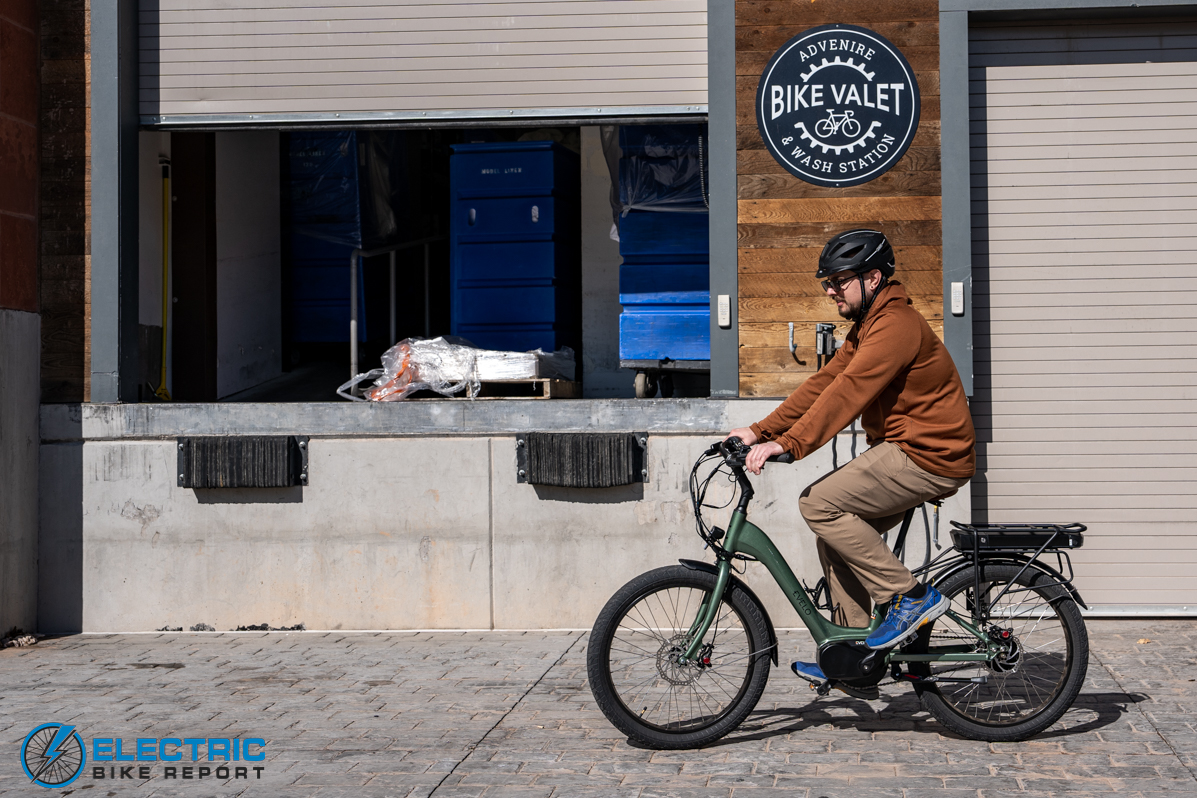
While a bit on the small side for me, the Galaxy SL’s frame accommodates riders between 4’-10” and 5’-10”.
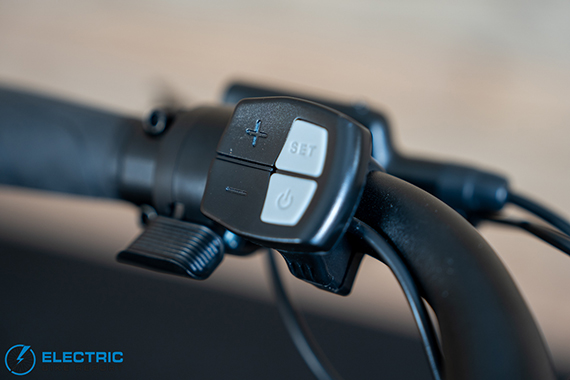
The SL’s large, clicky control panel provides a nice tactile response so you know when you’ve hit a button.
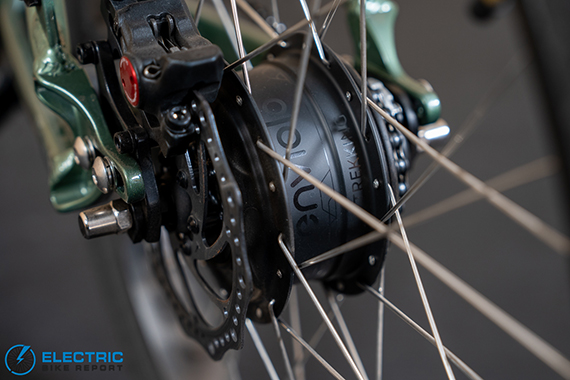
Instead of a motor, the rear hub houses an infinitely-adjustable, gearless continuously variable transmission, or CVT.
Evelo Galaxy SL Review: Range Test & Battery Performance
Evelo’s website states that the Galaxy SL has a maximum range of up to 50 miles. To test that claim, we performed two tests at different assistance levels to see how long the 36V, 13 Ah battery would last under real-world conditions. The first test was conducted exclusively in PAS 1 to measure maximum distance, while the second used only PAS 5 to measure minimum range.
Overall, the Galaxy SL proved to have respectable results. In PAS 5, using maximum power, the Galaxy SL traveled a distance of roughly 25 miles. Using PAS 1, the 36V, 13 Ah battery gave out after about 49 miles. Many more factors affect the range of an e-bike than we can measure, including terrain, weather, rider/cargo weight, etc., so our figure is a ballpark estimate. With that in mind, we consider Evelo’s stated range accurate, though under real-world use where a rider switches between PAS levels, the range will certainly vary.
The Galaxy’s battery is worth discussing a bit more in detail. Unlike many other e-bikes where the battery mounts or integrates with the frame’s down tube, both models feature a rear cargo rack with a horizontal slot for their battery. A rear taillight and brake light is integrated into the back end of the battery itself, which is a great standard feature for added safety. The placement under the rear rack makes the battery easy to remove when needed, and as with most e-bikes, a key lock keeps the battery secure at all other times. Note that the Galaxy batteries do have separate on/off switches from the bikes themselves, so it is necessary to activate both when starting up. I personally like this feature due to its added level of control, but it IS an additional thing to remember.
Evelo Galaxy SL Review: Hill Test
As mentioned previously, the Galaxy SL’s motor is tuned for easier hill climbing in PAS levels 3-5. To test the full capability of the SL, we tried it out on our test hill in a process described in the graphic above.
In PAS 5, the Galaxy SL had no trouble ascending the steep slope. It wasn’t the speediest climb we’ve ever seen, but the motor’s 95Nm of torque did the proverbial trick well. Using only its throttle, the bike still made it to the top (which makes it a successful trial!) but did seem to be more markedly on the slow side. When comparing the SL to the Lux in this instance, I am betting that the difference in voltage is the main relevant point of differentiation, considering that the motors of the bikes are essentially identical.
Speaking of the motor, it is worth pointing out again that both Galaxy models feature mid-drive motors. In contrast with some of the rear-hub motors on the market, mid-drives tend to feel more like a traditional bicycle when riding. The Galaxies’ Dapu motors use a combination of torque and cadence sensors, which measure the amount of input from the rider and respond accordingly. As such, going uphill can require a bit more effort than some other models with just cadence sensors and a rear hub motor. That said, the motor on the Galaxy SL still does the vast majority of the work in PAS 5.
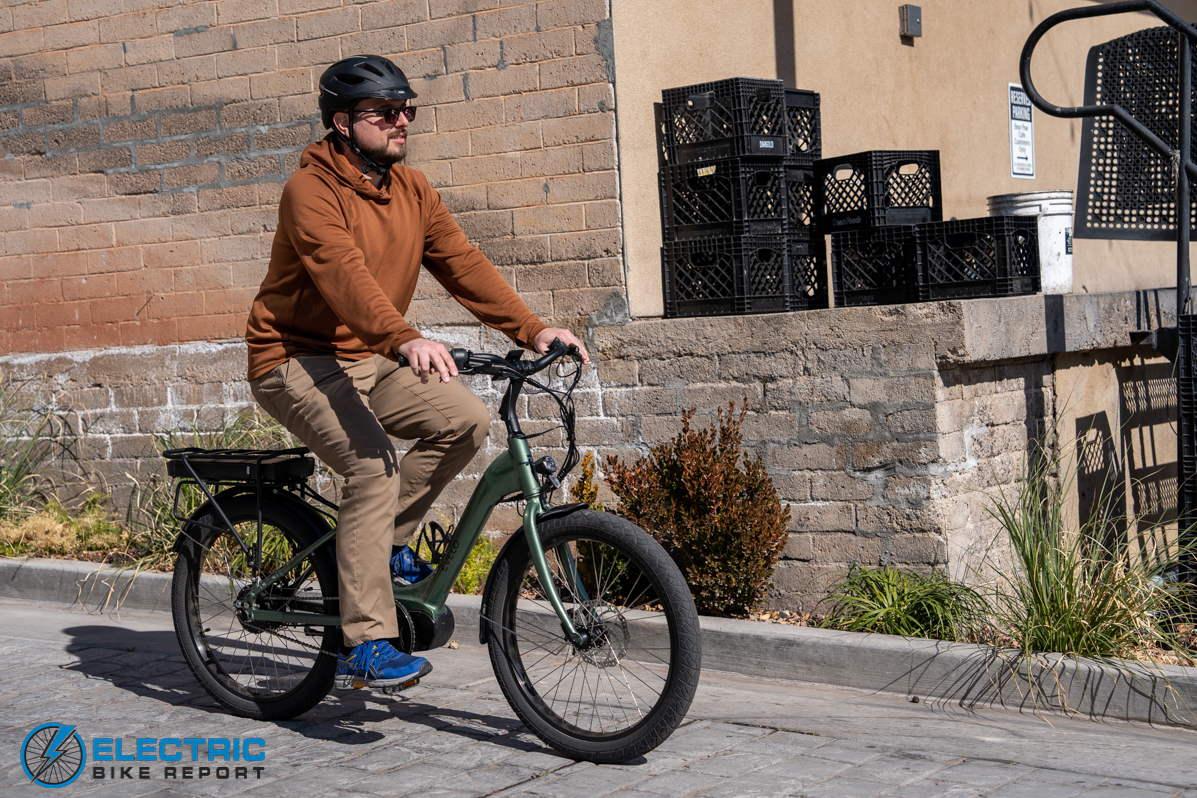
The SL’s 24” wheels and mid-drive motor make for a zippy, maneuverable e-bike.
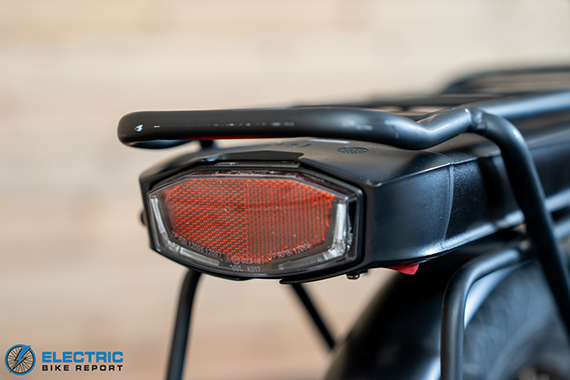
The battery, which slots under the rear cargo rack, features integrated tail- and brake lights.
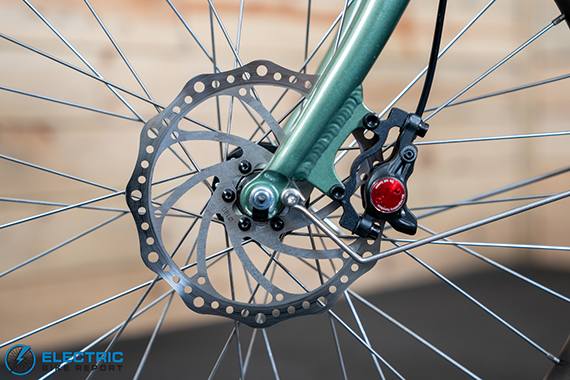
The SL’s Zoom hydraulic disc brakes have 180mm rotors on the front wheel and 160mm rotors on the rear.
Evelo Galaxy SL Review: Safety and Brake Test
The Evelo Galaxy SL comes equipped with a full complement of safety features that we like to see as standard inclusions. In addition to the aforementioned battery features (taillight and rear brake light), the SL features an integrated headlight, front and rear reflectors, and quality brakes. It comes equipped with 180mm front and 160mm rear Zoom hydraulic disk brakes with a motor cutoff switch, which stops power from the motor when the bike’s brake levers are pulled. These are all great features on an e-bike, especially when considering that they are more difficult to slow and stop due to their potential speeds.
To test the Galaxy’s brake system, we got the bike up to its maximum assisted speed of 20 mph, then measured the distance it took to come to a complete, controlled stop. With three repetitions of this test, we were able to calculate an average stopping distance.
At 23’4”, the Galaxy SL was a little on the slower side when it came to stopping. An increase on the rear rotor size from 160mm to 180mm could help the SL out significantly, so it would be great to see that change on the next updated version of the bike.
I should also point out that, outside of our measured brake test, the Galaxy SL’s rear wheel had a tendency to lock up and skid under hard braking conditions. As a former BMX rider, I personally didn’t mind this (or consider it dangerous), but the fact that the bike likes more gradual slowing is just something to keep in mind when riding.
One final safety feature I want to draw attention to is Evelo’s battery management software (BMS). Safety can be a concern both on and off the road, and a good BMS prevents the battery from being overcharged. I won’t dive into the complexities of the potential dangers inherent to rechargeable batteries here (we have a full article on that here), but I will state that proper charging practices can prevent problems from occurring, and battery management software adds an important additional layer of protection that is not always included.
Evelo Galaxy SL Review: Ride Comfort & Handling, Cockpit, and More
When discussing the Galaxy SL’s ride comfort, a significant caveat is that so much comes down to personal preference. For various reasons, comfort was the area I had the greatest number of concerns with regarding the bike, but my comments should certainly be taken with a grain of salt. My points of critique may not overlap with everyone. Fortunately, I am able to consult my fellow reviewers for their input, so I will try to offer a consensus or at least point out when I am not.
For example, my height exceeds that of the bike’s recommended range, but just barely. In fact, all but one of our testers measure at or above the SL’s recommended height limit. The Galaxy SL is designed to fit riders between 4’10” and 5’10”, so with my height of 5’11”, the bike did seem a little small to me. One of our other reviewers who sits on the lower end of the SL’s height range felt differently, though; she found the frame to be comfortable and sized correctly. For weight purposes, which I discussed previously, the frame size and subsequent rider height range makes sense. This smaller size helps to keep the bike’s weight down, which gives it the ability to be lifted or transported more easily.
In line with its beach cruiser styling, the Galaxy SL features swept-back handlebars for a casual riding experience. Personally, I am not the biggest fan of this style due to my previously mentioned wrist issues, but they are generally OK for shorter rides, and I understand the appeal. Our other testers had no issues with the shape. While I prefer an ergonomic shape somewhere between cruiser-style and flat handlebar design, I did still appreciate some of the features included on the SL. The bike’s ergonomic rubber grips were comfortable, and its relatively compact cockpit layout ensured that all of the included controls were easy to reach without straying far from them.
The Galaxy SL’s left handlebar hosts a throttle lever, brake lever, and the bike’s controller, while the right side accommodates the twist shifter and other brake lever. As is common with e-bikes, the full-color LCD display is mounted centrally over the stem. It’s a simple, effective layout, with the only additional thing we’d like to see included being a bell (which would be another safety benefit and only add to the bike’s cruiser styling). Fortunately, that accessory is inexpensive and easy to add after the fact.
I have discussed the brakes and twist shifter in previous sections (the throttle lever is standard and unnecessary to discuss further), but I want to elaborate a bit more about the Galaxy SL’s user interface, its control pad and display. Overall, the interface felt a bit dated in our contemporary world of smartphones with less tactile , but that critique is minor when considering its benefits. In contrast with many e-bikes outfitted with small control pads and rubberized buttons arranged tightly together, the Galaxy SL’s pad is large, made of hard plastic, and clicky. The size and layout makes the buttons themselves easy to read and easy to accurately hit, while the clicks give a clear signal that you’ve activated one. Curiously, the bike we received for testing had a different display than the one shown on the Galaxy SL’s webpage (at the time of writing). While the version shown there displays a clean, easy to read arrangement of metrics, the one on our test bike felt a bit busy to me and took some time to adjust to. It was fine after I learned where to look for the information I wanted to reference, though I admit I would personally prefer the more simplified design. I reached out to Evelo for clarification regarding the difference in displays, and was told that we received the newest, most updated version, while the website hasn’t quite caught up (again, at time of writing).
With the Galaxy SL’s technological features and controls covered, let us dive into the riding experience itself. As I mentioned, the SL’s mid-drive motor gives it the feel of a more traditional non-electric bike. Its 24” wheels are a nice compromise between 20” and 26” wheels, making the bike feel nimble and highly maneuverable, in addition to reducing size and weight. They are certainly a less common size, however, and may not be as easy to find replacements for.
Another feature to discuss is the Galaxy SL’s saddle. Its styling and color add to the bike’s classic design, and certainly enhance its visual appeal. That said, I personally found it to feel pretty hard after only about 20 minutes on the bike, and our other testers agreed. I think the old-school saddle that this one is trying to emulate would feel similarly (or even more) firm, so it shouldn’t come as a surprise, but if you’re looking for a more comfortable ride, I would consider looking into Evelo’s list of accessories. Fortunately, they offer multiples of both padded saddle and suspension seatpost options.
One final note regarding the fenders. I appreciate seeing fenders included on a bike where appropriate, and the Galaxy SL is one of those cases. Thanks to some recent rainy weather locally, I was able to put the bike’s fenders to the test. Overall, they did a fairly good job of keeping my pants dry, though I did end up with a few spots from splashes. That was expected considering the SL’s slim fender design, but it’s worth pointing out that they were not quite as effective as wide, full coverage fenders would be.
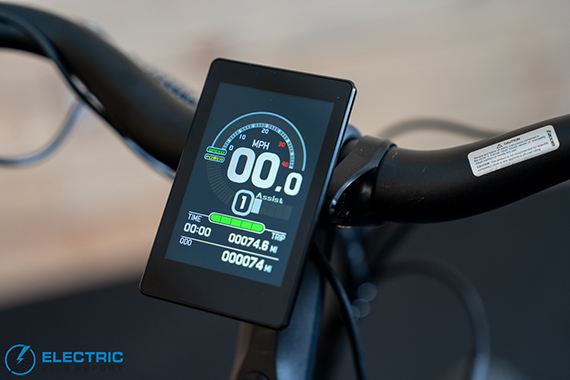
The Galaxy SL features a centrally-mounted, full color LCD display to show speed, PAS setting, battery level, and more.
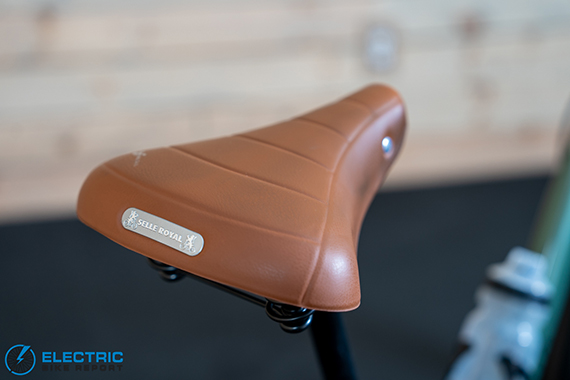
While the saddle didn’t quite suit our personal level of desired comfort, it certainly adds to the aesthetic of the bike.
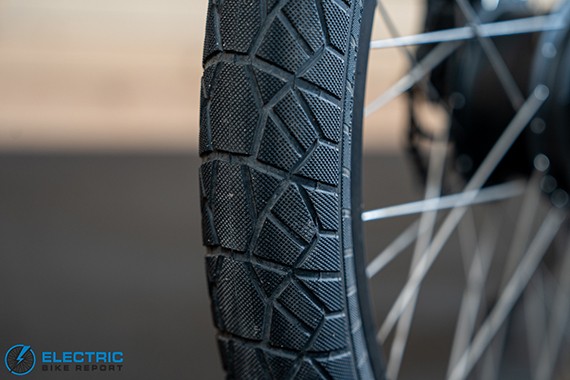
The CST Cyclops 24” x 2.4” tires roll smoothly and help the bike zip around easily on paved surfaces.
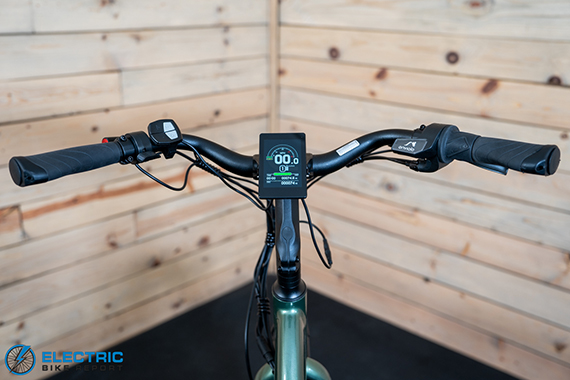
The SL’s cockpit spreads controls out well for easy reach from the grips.
Evelo Galaxy SL Review: Summary / Where to Buy
With the Galaxy SL, it seems that Evelo set out to make an everyman’s ride, and I believe they generally succeeded.
The bike combines iconic styling with a myriad of desirable features, including simple, practical elements such as the rear cargo rack, front and rear lights, and fenders, as well as higher-end inclusions like the gearless CVT and mid-drive motor. The SL offers a full complement of name brand components, including the Zoom brakes, Dapu motor, and KMC chain drive, and it is backed up by an exceptional 4-year warranty. Its thoughtful design allows it to be more accessible to ride, transport, and interact with for a relatively wide range of users, including casual/inexperienced riders, seniors, and those with disabilities.
All of these elements come together in a bike with solid (sometimes surprising) performance, and a few quirks. For all its lean towards accessibility, the Galaxy SL does leave out riders on the taller end, but fortunately, Evelo offers other models which can better accommodate them. Similarly, for those who may have limited range of motion in their wrists (or other issues) that may interfere with use of the twist shifter, the higher end Galaxy Lux model eliminates shifting almost entirely. And finally, in the case of the saddle and its comfort, so much about a bike depends on the rider. Fortunately, parts can be changed out based on personal preference for a more customized feel, and Evelo offers a few options.
The Galaxy SL isn’t the speediest, most powerful, most universal, or even the most decked-out e-bike we’ve ever seen, but it’s not trying to be. It doesn’t have to be. It’s just trying to be a solid, dependable ride for commuting to work, cruising along the beach, or just going for a spin around the neighborhood. And in that, it succeeds with high marks.
Happy Riding, make sure to let us know if you have any questions down in our comments section or if you think we left anything out in this review of the Evelo Galaxy SL.


